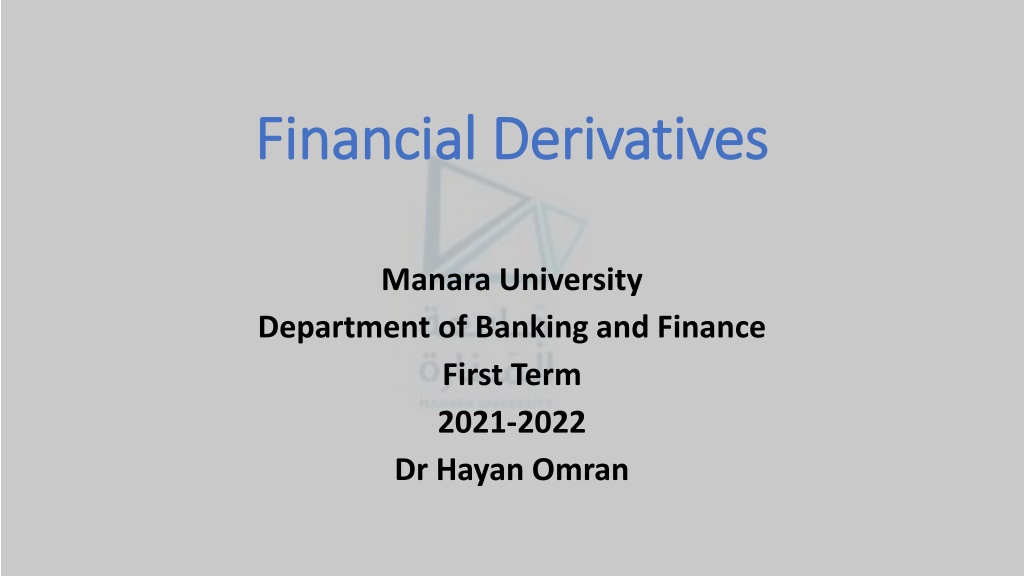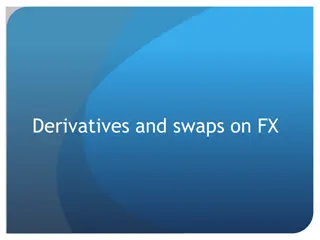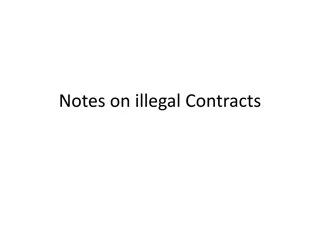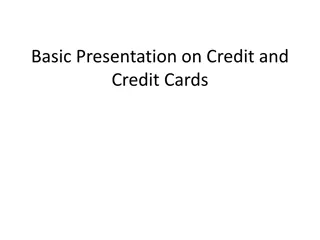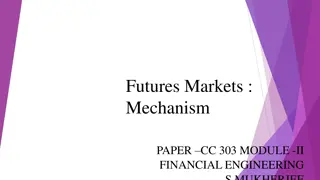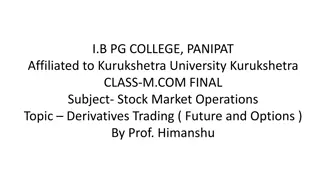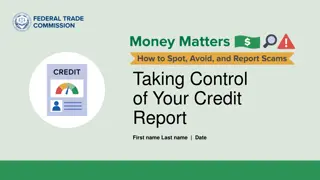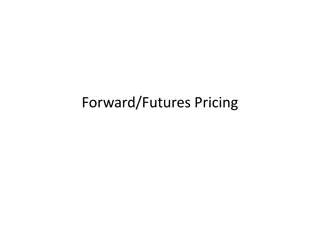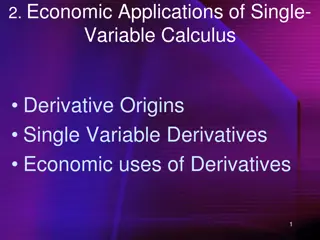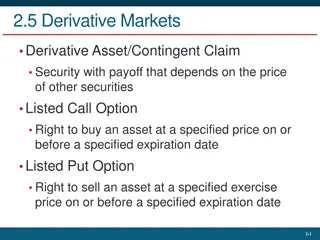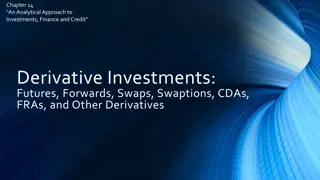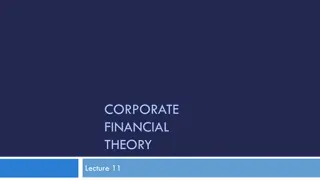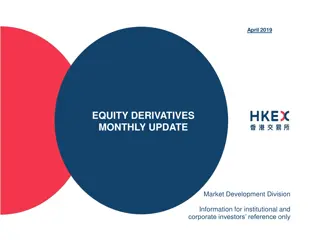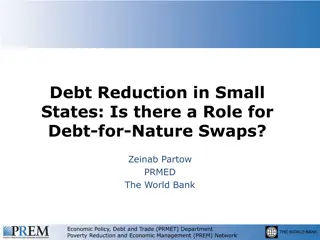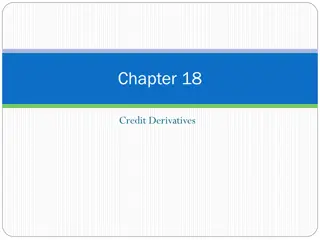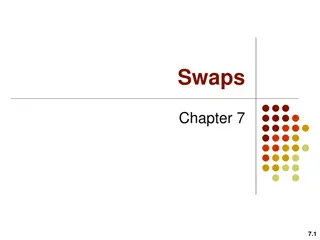Understanding Financial Derivatives: An Overview of Forward Contracts, Futures, Options, Swaps, and Credit Derivatives
Financial derivatives play a crucial role in managing risk and speculation in financial markets. This overview covers the definitions and characteristics of forward contracts, futures contracts, options (calls and puts), swaps, and credit derivatives. Swaps involve exchanging payments over time, while options give the right to buy or sell assets at set prices. Each derivative has unique features and purposes, catering to various risk management needs.
Download Presentation

Please find below an Image/Link to download the presentation.
The content on the website is provided AS IS for your information and personal use only. It may not be sold, licensed, or shared on other websites without obtaining consent from the author. Download presentation by click this link. If you encounter any issues during the download, it is possible that the publisher has removed the file from their server.
E N D
Presentation Transcript
Financial Derivatives Financial Derivatives Manara University Department of Banking and Finance First Term 2021-2022 Dr Hayan Omran
Define forward contracts, futures contracts, options (calls and puts), swaps, and credit derivatives and compare their basic characteristics Swaps: Swaps are agreements to exchange a series of payments on periodic settlement dates over a certain time period (e.g., quarterly payments over two years). At each settlement date, the two payments are netted so that only one (net) payment is made. The party with the greater liability makes a payment to the other party. The length of the swap is termed the tenor of the swap and the contract ends on the termination date.
Swaps are similar to forwards in several ways: Swaps typically require no payment by either party at initiation. Swaps are custom instruments. Swaps are not traded in any organized secondary market. Swaps are largely unregulated. Default risk is an important aspect of the contracts. Most participants in the swaps market are large institutions. Individuals are rarely swaps market participants.
There are swaps facilitators who bring together parties with needs for the opposite sides of swaps. There are also dealers, large banks, and brokerage firms who act as principals in trades just as they do in forward contracts.
In the simplest type of swap, a plain vanilla interest rate swap, one party makes fixed-rate interest payments on a notional principal amount specified in the swap in return for floating-rate payments from the other party. A basis swap involves trading one set of floating rate payments for another. In a plain vanilla interest rate swap, the party who wants floating-rate interest payments agrees to pay fixed-rate interest and has the pay-fixed side of the swap. The counterparty, who receives the fixed payments and agrees to pay variable-rate interest, has the pay-floating side of the swap and is called the floating-rate payer. The payments owed by one party to the other are based on a notional principal that is stated in the swap contract.
Options: An option contract gives its owner the right, but not the obligation, to either buy or sell an underlying asset at a given price (the exercise price or strike price). While an option buyer can choose whether to exercise an option, the seller is obligated to perform if the buyer exercises the option. The owner of a call option has the right to purchase the underlying asset at a specific price for a specified time period. The owner of a put option has the right to sell the underlying asset at a specific price for a specified time period.
The seller of an option is also called the option writer. There are four possible options positions: 1. Long call: the buyer of a call option has the right to buy an underlying asset. 2. Short call: the writer (seller) of a call option has the obligation to sell the underlying asset. 3. Long put: the buyer of a put option has the right to sell the underlying asset. 4. Short put: the writer (seller) of a put option has the obligation to buy the underlying asset.
The price of an option is also referred to as the option premium. American options may be exercised at any time up to and including the contract s expiration date. European options can be exercised only on the contract s expiration date.
At expiration, an American option and a European option on the same asset with the same strike price are identical. They may either be exercised or allowed to expire. Before expiration, however, they are different and may have different values. In those cases, we must distinguish between the two.
Credit Derivatives: A credit derivative is a contract that provides a bondholder (lender) with protection against a downgrade or a default by the borrower. The most common type of credit derivative is a credit default swap (CDS), which is essentially an insurance contract against default. A bondholder pays a series of cash flows to a credit protection seller and receives a payment if the bond issuer defaults.
Another type of credit derivative is a credit spread option, typically a call option that is based on a bond s yield spread relative to a benchmark. If the bond s credit quality decreases, its yield spread will increase and the bondholder will collect a payoff on the option.
Describe purposes of, and controversies related to, derivative markets The criticism of derivatives is that they are too risky, especially to investors with limited knowledge of sometimes complex instruments. Because of the high leverage involved in derivatives payoffs, they are sometimes likened to gambling. The benefits of derivatives markets are that they: Provide price information. Allow risk to be managed and shifted among market participants. Reduce transactions costs.
Explain arbitrage and the role it plays in determining prices and promoting market efficiency Arbitrage is an important concept in valuing (pricing) derivative securities. In its purest sense, arbitrage is riskless. If a return greater than the risk-free rate can be earned by holding a portfolio of assets that produces a certain (riskless) return, then an arbitrage opportunity exists. Arbitrage opportunities arise when assets are mispriced. Trading by arbitrageurs will continue until they affect supply and demand enough to bring asset prices to efficient (no-arbitrage) levels.
There are two arbitrage arguments that are particularly useful in the study and use of derivatives. The first is based on the law of one price. Two securities or portfolios that have identical cash flows in the future, regardless of future events, should have the same price. If A and B have the identical future payoffs and A is priced lower than B, buy A and sell B. You have an immediate profit, and the payoff onAwill satisfy the (future) liability of being short on B.
The second type of arbitrage requires an investment. If a portfolio of securities or assets will have a certain payoff in the future, there is no risk in investing in that portfolio. In order to prevent profitable arbitrage, it must be the case that the return on the portfolio is the risk free rate. If the certain return on the portfolio is greater than the risk free rate, the arbitrage would be to borrow at Rf, invest in the portfolio, and keep the excess of the portfolio return above the risk free rate that must be paid on the loan. If the portfolio s certain return is less than Rf, we could sell the portfolio, invest the proceeds at Rf, and earn more than it will cost to buy back the portfolio at a future date.
Examples Examples 1. Which of the following statements most accurately describes a derivative security?Aderivative: A. always increases risk. B. has no expiration date. C. C. has a payoff based on an asset value or interest rate. Aderivative s value is derived from another asset or an interest rate.
2. Which of the following derivatives is a forward commitment? A.Stock option. B.Interest rate swap. C.Credit default swap. An interest rate swap is a forward commitment because both counterparties have obligations to make payments in the future. Options and credit derivatives are contingent claims because one of the counterparties only has an obligation if certain conditions are met.
3. Which of the following statements about exchange-traded derivatives is least accurate? Exchange-traded derivatives: A. are liquid. B. are standardized contracts. C. C. carry significant default risk. Exchange-traded derivatives have relatively low default risk because the clearinghouse stands between the counterparties involved in most contracts.
4.A custom agreement to purchase a specific T-bond next Thursday for $1,000 is: A. an option. B. a futures contract. C. a forward commitment. This type of custom contract is a forward commitment.
5. Interest rate swaps are: A. highly regulated. B. equivalent to a series of forward contracts. C. contracts to exchange one asset for another. A swap is an agreement to buy or sell an underlying asset periodically over the life of the swap contract. It is equivalent to a series of forward contracts.
6.Acall option is: A. the right to sell at a specific price. B. the right to buy at a specific price. C. an obligation to buy at a certain price. A call gives the owner the right to call an asset away (buy it) from the seller.
7. Arbitrage prevents: A. market efficiency. B. earning returns higher than the risk-free rate of return. C. two assets with identical payoffs from selling at different prices. Arbitrage forces two assets with the same expected future value to sell for the same current price. If this were not the case, you could simultaneously buy the cheaper asset and sell the more expensive one for a guaranteed riskless profit.
8. Derivatives are least likely to: A. improve liquidity. B. provide price information. C. prevent arbitrage. While derivatives prices are the result of potential arbitrage, they do not prevent arbitrage. Derivatives improve liquidity and provide price information.
